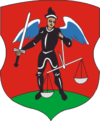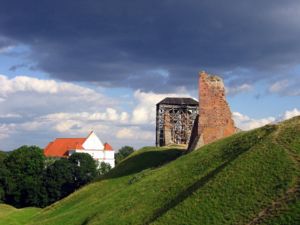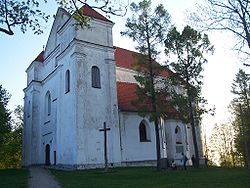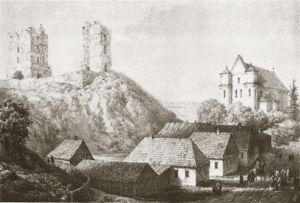- Navahrudak
-
Навагрудак / Navahrudak
Новогрудок / Novogrudok
SealLocation of Navahrudak, shown within the Hrodna Voblast Coordinates: 53°35′N 25°49′E / 53.583°N 25.817°E Country
SubdivisionBelarus
NavahradakFounded 1044 Elevation 292 m (958 ft) Population (2004) – Total 30,803 Time zone EET (UTC+2) – Summer (DST) EEST (UTC+3) Area code(s) +375-1597 License plate 4 Website [1] Navahrudak (Belarusian: Навагрудак, [navaˈɣrudak]), [1] is a city in the Hrodna voblast, Belarus.
Contents
Early history
First mentioned in the Sophian First Chronicle and Fourth Novgorod Chronicle in 1044 in relation to a war of Yaroslav I the Wise against Lithuanian tribes.[2] It was also mentioned in the Hypatian Codex under 1252 as Novogorodok (i.e. "new little town") the town was a major settlement in the remote western lands of the Krivichs that came under the control of the Kievan Rus at the end of the 10th century. Later hypothesis is disputed, as there are earliest archaeological findings from 11th century only.[3]
In the 13th century, the fragile unity of the Rus disintegrated due to nomadic incursions from Asia, which reached a climax with the Mongol Horde's sacking of Kiev (1240), leaving a geopolitical vacuum in the region later to be known under the conventional name Black Ruthenia. The Early East Slavs splintered along preexisting tribal lines into a number of independent and competing principalities.
Mindaugas of Lithuania made use of the plight to annex Navahrudak, which also became part of Kingdom of Lithuania,[4][5][6][7][8][9][10] later Grand Duchy of Lithuania. During the 16th century, Maciej Stryjkowski was the first who, in his chronicle,[11] proposed theory, that Navahrudak became the capital of the 13th century state. This statement is supported by several other scholars, while others dispute this notion, mainly because contemporary chronicles of the 13th century do not give any reference about Navahrudak as capital, even stating that city was transferred to the king of Halych-Volhynia.[12] Vaišvilkas, the son and successor of Mindaugas, took monastic vows in Lavrashev Monastery[13] near Novgorodok and founded an Orthodox convent there.[14]
Later history
Navahrudak was a part of the Polish-Lithuanian Commonwealth following the Union of Lublin in 1569. In 1795 it was incorporated into Grodno Governorate of Imperial Russia due to the Partitions of the Polish–Lithuanian Commonwealth. The town was a center of thriving Jewish community, its 1900 population was 5,015.[15] In the First World War it was under German occupation from 1915 to 1918, and was occupied by the Polish Army at first, later the Red Army, during the Polish-Bolshevik war. It was given to Poland by the treaty of Riga, following which Navahrudak became the capital of Nowogródek voivodship.
Soviet troops entered the city in September 1939 and it was annexed into the Soviet Union via the Byelorussian SSR. In the administrative division of the new territories, the city briefly (November 2, to December 4;) was the centre of the Navahrudak Voblast. Afterwards the administrative centre moved to Baranavichy and name of voblast was renamed as Baranavichy Voblast, the city became the centre of the Navahrudak Raion (January 15, 1940). On June 22, 1941 Nazi Germany invaded the USSR and Navahrudak was occupied on July 4, following one of the more tragic events when the Red Army was surrounded in what's known as the Novogrudok Cauldron. See Operation Barbarossa: Phase 1.
During the German occupation it became part of the Ostland. Partisan resistance immediately began, with most famous Bielski partisans made of Jewish volunteers operated in the region. On 1 August 1943, Nazi troops shot down eleven nuns, the Martyrs of Nowogródek. The Red Army reoccupied the city almost exactly three years after its German occupation on July 8, 1944. During the war more than 45,000 people were killed in the city and in the surrounding area, and over 60% of housing was destroyed.
After the war, the BSSR retained the city, and a rapid rebuilding process quickly restored most of the destroyed infrastructure. On July 8, 1954, following the disestablishment of the Baranavichy Voblast, the raion, along with Navahrudak became part of the Hrodna Voblast, in which it remains to this day, in modern Belarus.
Navahrudak was an important Jewish center. It was the birthplace of the Mussar movement as well as the hometown of Yiddish lexicograph Alexander Harkavy. Prior to the war, the population was 20,000, of which about half were Jewish; Meyer Meyerovitz and Meyer Abovitz were the Rabbis there at that time. During a series of "actions" in 1941, the Germans killed all but 550 of the approximately 10,000 Jews. Those not killed were sent into slave labor. [2]
Sights
 Ruins of Navahrudak Castle. Current state.
Ruins of Navahrudak Castle. Current state.
The stone castle, so called Mindaugas' Castle, built in the 14th century is now in ruins; as it was burnt down by the Swedes in 1710. The Orthodox Cathedral of Sts. Boris and Gleb, started in 1519 in the Gothic style, was not completed until the 1630s; it was extensively repaired in the 19th century. Other architectural attractions include the Transfiguration Church (1712–23), where Adam Mickiewicz was baptised, the Church of St. Michael, renovated in 1751 and 1831, and the shopping mall in the central square.
Navahradak was an important shtetl and home to the Harkavy Jewish family, including Alexander Harkavy. Some of the Harkavy are buried at the old Jewish cemetery of Navahrudak. A house is shown where the poet Adam Mickiewicz was born; there are also his statue and the "Mound of Immortality", created in his honour by the Polish administration in 1924–31.
Notes and references
- ^ Also Novgorodok, Novogrudok (Russian: Новогрудок) or Nowogródek in Polish
- ^ Н.П.Гайба. История Новогрудка
- ^ Oshchestvo Srednevekovoj Litvy
- ^ D. Antanavičius, D. Baronas etc. Mindaugo knyga: istorijos šaltiniai apie Lietuvos karalių. Vilnius, 2005. pp.63-93
- ^ K Steponaitis. Mindaugas ir Vakarai : vokiečių militarinių ordinų veikla ir Mindaugo santykiai su Roma.p 68.
- ^ J. Geddie. The Russian Empire: Historical and Descriptive. P.102
- ^ J. Phillips. The Medieval Expansion of Europe. p. 78
- ^ Mindaugas, the King of Lithuania
- ^ T. Baranauskas. Lietuvos karalystei – 750 (Kingdom of Lithuania -750)'.2001
- ^ E. Raczynski. Codex diplomaticus Lithuaniae e codicibus manuscriptis in Archivio secreto Regiomontano asservatis
- ^ Maciej Stryjkowski (1985). Kronika polska, litewska, żmódzka i wszystkiéj Rusi Macieja Stryjkowskiego. Warsaw: Wydawnictwa Artystyczne i Filmowe. pp. 572.
- ^ Полное собрание русских летописей. Ипатьевская летопись. Москва, 1998. pp.880-881
- ^ Following the Tracks of a Myth Edvardas Gudavičius
- ^ S.C. Rowell. Lithuania Ascending: A Pagan Empire Within East-central Europe, 1295-1345. Cambridge University Press, 1994. Page 149.
- ^ JewishGen.org
External links
Coordinates: 53°35′N 25°49′E / 53.583°N 25.817°E
Subdivisions of Grodno Region, Belarus Districts
(raiony)Ašmiany · Astraviec · Berestovitsa · Dziatłava · Hrodna · Iŭje · Kareličy · Lida · Masty · Navahrudak · Ščučyn · Słonim · Smarhoń · Śvisłač · Vaŭkavysk · Voranava · Zelva
District
centresCities Categories:- Hrodna Voblast
- Populated places in Belarus
- Shtetls
- Populated places established in the 11th century
Wikimedia Foundation. 2010.




